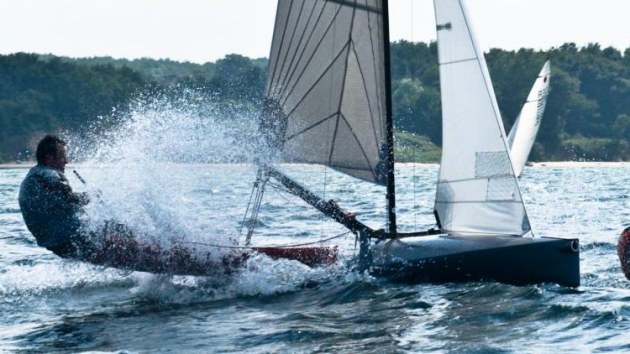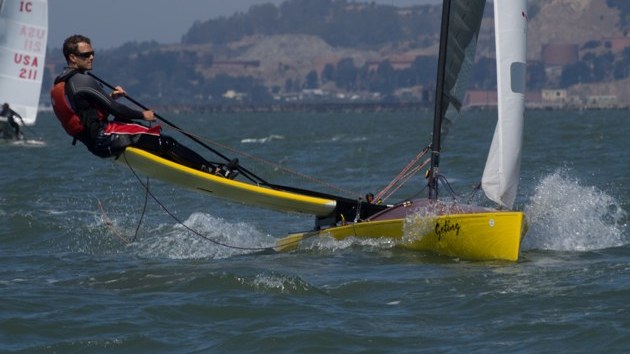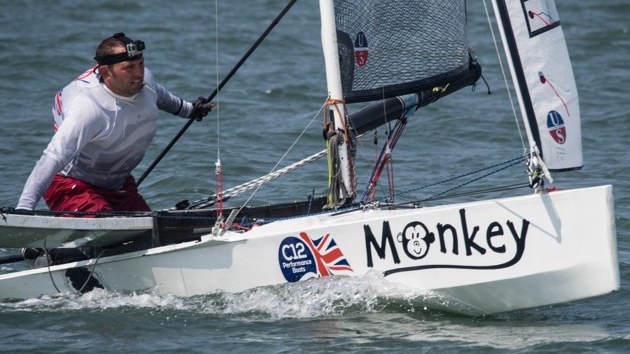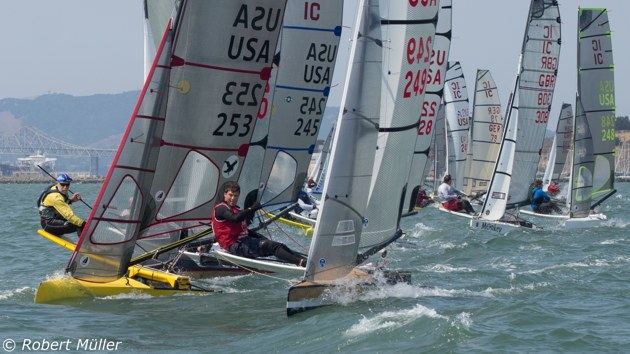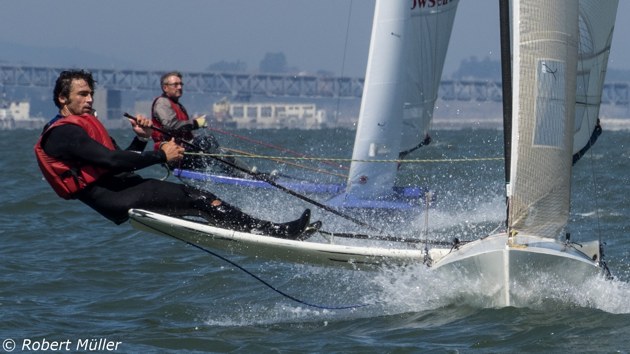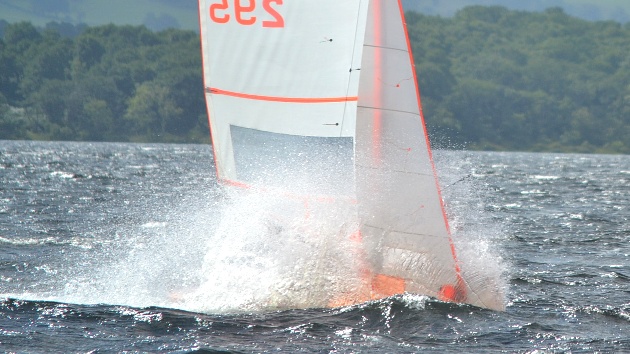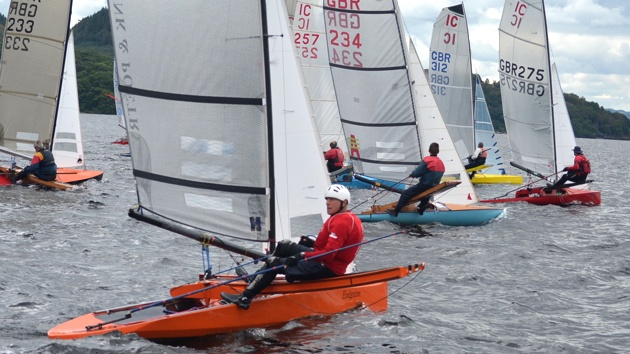International Canoe Worlds 1984
Angelholm, Sweden
UK report
The triennial world championship of the International 10 Square meter canoe Class was held at Angelholm in Sweden. In the most dramatic reversal of form ever seen since the day when Uffa Fox and Roger De Quincey took the championship from the Americans in the 'thirties, the Swedes - who have dominated world events for more than 10 years - were buried by an avalanche of American and British boats. The best of the Swedish team, the defending world champion Max Tollquist, could only just scrape into the top 6 overall. The majority of the other Swedes populated the positions between 20 and 40 in the record sized fleet.
The main reason for the Swedish failure may have been that the series was dogged by light winds that only once rose above 10 knots in seven races. It is equally likely that the top British sailors would have done even better, even win the four day series, if there had been a greater average wind strength. In the few moments during one race when there was enough wind for helmsmen to hand off the end of their sliding seats Colin Brown in particular appeared to have sufficient speed on all legs of the course. [Editor's note - even for a report in a UK magazine this report seems a little nationally biased! Colin Brown finally won a major International event when he won the Europa Cup in 2013] In the final analysis the top Americans had a slight edge in boat speed in the lighter conditions which most expert opinion considered to be due to the extra fullness of their sails.
Racing was extremely close, and it was only after the fourth race when Steve Clark of America took his second victory that he began to emerge as the most likely champion. Sailing the remainder of the series with remarkable consistency never finishing outside the first three, he was assured of the championship as long as he finished better than ninth in the final race.
Sadly for the two leading British helmsmen, Colin brown and Patrick Marshall, lying second and fourth before the final race they both recorded their worst results of the event when it mattered most leaving two more Americans to fill second and third positions.
To rub salt into the wounds the Americans had issued a challenge to Sweden for the venerable match race trophy, the New York Cup. In the gusty conditions the Swedes gave the Americans one hell of a fight. Clark was the only Yank with the speed needed and he managed to win two out of the three races followed each time by all three Swedish sailors.
The Americans all sailed wood-decked glassfibre hulls. The lay-up of the shells was simple chopped strand glass and styrene resin in all cases except Clark's boat which featured glass cloth and epoxy resin with local carbon fibre reinforcements. All the boats were built by Clark and Van Deusen's Quarter Moon Yacht Company. Their rigs were far more exotic with carbon fibre masts and booms weighing about half the standard Proctor stick. Their sails were almost all the product of Rod Mincher's Severn Sails in Annapolis. The top British boats by contrast were all wood Tony Miles hulls sporting Aitken and Wane Sails on Proctor D section spars.
Chris Eyre
This report first appeared in "Yachts and Yachting" magazine. Many thanks to Gael Pawson and Creating Waves Ltd for facilitating reproduction here.
US report by Steve Clark
The Americans went to Sweden hopeful but not very confident about their prospects. None of us had sailed Internationally for three years and although scouting reports from England indicated we were still on pace, stories of Colin Brown's breakaway speed and memories of the Swedish near domination of the 81 Worlds made overconfidence very difficult. We were pretty sure that we had made progress in technique and tuning, were "sure" the new boats were faster than the old and that carbon fiber masts were definitely quicker. Then we thought of how fast Dr. Bob, Chip Johns, Steve Chamberlin, and Bob Blomquist are all going with standard boats and wondered whether or not progress had in fact been made. For my part I was sure that two silver medals (in 78 and 81) were no guarantee of success and was very concerned about my speed. After a two year losing streak to Chris Converse and Hannah I was feeling more like a bridesmaid than a contender for the gold. It promised to be an interesting regatta.
The container arrived two days late on the wrong set of wheels but the boats were intact except for some nicks and abrasions. Some phone calls set things right. Fullers missed first plane and lost Leslie's bag. Hannah and Chris were waylaid in Paris. Ted and Trudy's plane had a flame out on take off, Del left a bag in Malmo, Kim and I almost smacked up the Saab, and Per discovered his father's VW didn't stop so good. But nobody died and by Friday afternoon Team USA was ready for action. I had snuck out on Wednesday and Thursday to see what I could find out and was encouraged by the fact that Colin Brown pointed higher and went slower and Max Tollqvist didn't go faster. So I was encouraged. Then it was time for a little team tuning and I felt a bit shocked by the way Hannah ran away and hid and how quick everyone seemed to be.
Measurement went off pretty much without a hitch except for Del's Humongus Pineapple Main. Severn mains and jibs all measured 9.94 — 10.004 (The latter being Hank's, she won measuring, the .004 being the biggest thing that rounds down!) Boat weighing by John Granbera was a comedy involving a boom scale and two strong boys. 64 kg. with everything imaginable on the boat was good enough to get you by — black bands via the approximate addition method kept us either in stitches or in a state of shock depending on whose boat was being measured. But by and large the storm was weathered well by all, and it was off to the practice race.
Because the Worlds was basically a "slow" regatta instead of a "speed and power" event, the racing had a very distinct character. For the last few years in the U.S. we have done a lot of this type of racing and so we are pretty good at it. Conditions were basically moderate: 2/3 to full slide but very little hiking and never really having to depower the rig. Down wind at fast displacement, only a few planing reaches. SSA without the chop or Barrington would be good comparisons. Under these conditions you have to be really aggressive about getting out in front of the pack. The boats are bunched up and interfering" with each other's air and anything you can do to stay ahead of the horde is vital. For example, there might be 30 seconds between lst and Stb but there is also only 30 seconds between 5th and 15th. So if you're in 3rd you don't waste a lot of time being tricky; the hounds are right behind. Also in races like this small differences in speed matter more early in the race than they do later on, because your chances to pass lots of boats are usually best in the first four legs when the boats are really bunched up. I think one of the major factors in the American's success was our speed and aggressiveness on the first two reaches. This is mainly due to Chris Converse who cranked "Cheeks" up and redefined fast—off—the-wind. Neutralizing his breakaway speed took a lot of hard work and basically made the whole U.S. Team faster down wind than any other at the Worlds. And this was the key to starting the second beat in good shape.
One might reach the conclusion that the American's success in Angleholm was the product of some new and innovative developments over the last three years. I do not want to denigrate what has been done to make the US IC's faster, but I still feel that the essential tuning was in place in 1981; conditions did not cooperate. In moderate air, canoe racing is like racing in any other dinghy class. In the States where we do a lot of moderate air sailing, our tune and tactics are very good and have been for at least four years. It is vaguely possible that we could have done this well as a team in Marion if the wind hadn't blown quite as hard. So it is hard to point to a few things and say they were the keys to success in Angleholm.
Primarily, we have altered our original concepts very little. There has been some nibbling to the left and right, but no one except for Chris on the team made the kind of departure from normal that the latter did in 1981 or Bob Blomquist did in '82. Yet there were some pretty big steps taken to refine the boats. Possibly the two areas where energy has been profitably expended is in foils and rigs. Hulls are all pretty good. Even the polyester single—skin King Ferry boats that no one thought much about in '81 managed to be 3 out of the top ten. The canoe rules are about right on weight, a 138 lb. hull is a good one, pretty durable and heavy enough to get stiffness without being weird about it. Although Greymatter is a super stiff epoxy/foam/glass construction, I have never had the feeling that it was the hull that made the difference in speed.
A quick look around the lot convinced me that the American centerboards were going to be part of the story. We have stuck to the original high—lift concept. Most of us are using NACA 000 Series foils with a modified eliptical plan form. The Swedes were using the same "mystery" section: with odd pointed tip planforms, which still make no sense to me. They go fast in a blow but I don't think it's the boards that do it. The English boards are more like ours, but their standard seems to be lower and they pay less attention to detail, so they are probably not as efficient. The Germans don't seem to see centerboards at all. With the exception of "Rosey Cheeks" all of the American ICs had dagger boards either in fixed trunks or in tipping cassettes. This trend will no doubt continue because it is such a good idea to eliminate the slot. The boat floats higher. The hull can be made stiffer because it doesn't have that great long hole in the middle of the structure. And serendipitously you eliminate the potential liability for gasket failure. Centerboard profiling becomes easier if the board doesn't have to sweep as far as a fully pivoting centerboard. Things like tip shape are more easily arrived at and the compromises are less drastic. The board can also be a little big because it is easy enough to "reef" it in a blow by pulling it up a bit. The boards I built over the last few years have bounced around a lot but have finally stabilized as a 10% NACA secti tapered on both the leading and trailing edge (keeps max camber in same place fore and aft). Top 2 B parallel sided bottom 3 tapers to 6 or 7" chord with % circular tip (pointing aft). Gonzo was the first boat to receive such a foil, and I liked what it did for Hannah's speed and so have cloned it a number of times.
Not much new in the world of rudders except for Van Dusen's articulated blade. The dedicated boat fiddler must have one in order to be competitive. Trudy's custom tailored sleeping bags for foils are very chic as well. The only disadvantage to Ted's rudder is that you can't scull and you shouldn't panic and pull really hard or else you blow the flap control off. (I think I would rather go sailing). The size issue seems to have resolved itself and people are tending to build slightly larger rudders than they were a few years ago. Fewer spinnouts. Del Olsen forgot that sweep increases torque. If you use a bolt for the pins they should have the heads cut off and not be held to the shaft with nuts. Bed the thing in lots of goop to keep stresses from concentrating. Other than that, more blade! Graham MacKareth made a different mistake. His shaft was welded to a flat plate about 1" below the top of the blade. Not enough bury. Must have made a sickening noise as he was doing well at the time. Back to the point!
Rigs. I have said all along that the carbon spurs don't seem much faster than the aluminum masts but that they make the boat easier to sail and thus pay for themselves. A case in point is a slightly blown tack in moderate air. With the lighter rig you can muscle the boat out of trouble. Not swimming is worth many lengths! This is strictly an ease—of—handling issue which doesn't show up until you have been on the water for three or four hours and are getting tired. A little bit of kindness lets you be a bit less precise at times and get away with it. Our rig geometry was pretty much standard fare, as near as I could tell without measuring anything. I have been using a system of lowering the hounds for lighter people and this seems to have worked well for Hannah by allowing the topmast to bend more and automatically free the leech in puffs. Establishing exactly the right compromise in masts is something I am still unsure of. Colin Brown used a Rondar "mighty screw" which controlled the lower panel of his mast quite effectively. In my experience; though, the boat usually feels better and goes faster if the lower panel is allowed to bend more and be more "responsive." This doesn't make a lot of sense, because it erodes shroud tension and distorts the hell out of the bottom of the main. I can think of a rationale along the lines of — opening the lower slot, increasing twist down low (sidebend=twist). Bringing the whole sail into a more "constant" angle of attack and adding "rake" to the rig. I don't know! As long as it works I'm not going to try to answer all the questions. Some Brits were sailing with drastically prebent rigs and went like mad.
A lot has, and should be said about the Severn Sails used by everyone on the U.S. team except Chris. Chris's Reynolds feels happier on the over—rotated stick. He chose not to mess with it. Del would have liked to use his power pineapple but then again at almost 8.5m2 it was ridiculously big. I was never sure how fast it was really except downwind. WOW! Del didn't like the severn main he borrowed from Chuck Domby.
The mains seem slightly fuller than the English Aitkin + Wane mains. The draft is further aft. The Swedish mains were flatter, as they were in '81. In the heavy air of the New York Cup they sailed with a lot more twist up high. Certainly the top Brits were giving no speed away in the moderate air. The Swedes didn't seem able to power up and point; is this sails or foils? I think the two are probably related. As stated above we have worked on midrange speed a lot more and let the high end take care of itself. Severn jibs were copied off of Olle Berqvist's '81 jib but are built like a sail instead of a blouse. They seem pretty fussy — about half way through the 3rd race I took some twist out and the boat came to life for the first time in 4 races. This was a question of 1.5" of outboard on the jib track. Nuts, it was a new jib for the Worlds and should have been just like the other one which was happy all the way in. The net effect was that, given the fact that the U.S. team had more boats in the front four or five boats in all races than any other team and that this was a consistant thing, there was probably a speed advantage there. It was not earned, it seems to me, with breakthroughs in any department but by carefully working on a pretty basic concept and refining it where possible. As a caveat I add that the Swedish boats were very tricky with lots of strings to pull, bells to ring, buttons to push and tassels that swung in opposite directions. They worked nicely and must have given them a sense of power. But they were basically doing nothing with the big pieces. As a result there were some nice solutions to problems like automatically uncleating the jib when you tack, and a centerboard up—haul which works nicely from both rails but can be lowered from a cleat on centerline. Ideas to incorporate on the next boat maybe, but not the kind of major innovations that we were playing with. It is, for example, hard to compare a few cleats and some bungee cord with.6 lbs. of graphite mast in the air. But at the same time the U.S. boats were not radically different from what we were sailing in 1980. A little better here and there. The weather helped.
This report first appeared in Canoesletter, 1984

